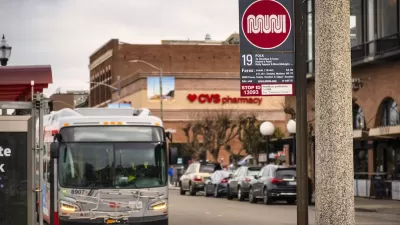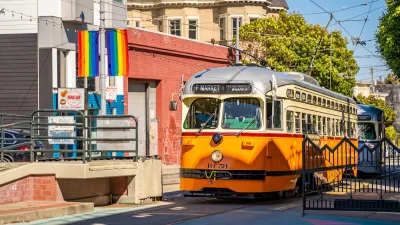This piece from the San Francisco Chronicle argues that the best way to improve the city's sluggish public transit system is to put it underground.
"Throughout the world, cities have recognized that dense urban areas can be adequately served only by separate rail rapid transit. We have the BART and Muni Metro systems, which provide this level of service to some parts of the city, but the densest quarter, north of Market Street and east of Van Ness Avenue, has no subways. We passengers have to endure buses that crawl along at walking speed. The planned Central Subway, which is an extension of the new T-Muni-Metro line, is our chance to finally provide world-class service to this part of the city."
"The Central Subway corridor is the fourth of four new rapid-transit corridors approved by voters in 1987 as part of the "four corridors plan." One, the Third Street lightrail line, has been built. Another two, Geary Boulevard and Van Ness Avenue (both of which are wide streets that can accommodate exclusive transit lanes), are slated to get Bus Rapid Transit. The Central Subway is the final link in this modern rapid transit system that is long overdue. A trip from Fourth and King streets to Chinatown that takes 22 minutes on a good day, longer if traffic is bad, will take seven minutes, every time, on a comfortable train."
"The San Francisco Planning and Urban Research Association supports this project, but with a couple of stern warnings. As proposed, the subway fails to make Muni much more efficient. Because it goes only as far as Chinatown, it does not directly serve much of northeast part of the city, therefore requiring slow, inefficient duplicative bus service to be retained. The subway should be extended to North Beach, serving a large population and allowing easy transfers from other lines. This could be done quickly and relatively inexpensively because the plan already calls for tunneling all the way to Washington Square, where an additional station easily could be built. Subsequently, the line could be extended to Fisherman's Wharf and the Van Ness rapid transit line, and from there possibly to the Presidio."
FULL STORY: How Muni can improve - go underground

Alabama: Trump Terminates Settlements for Black Communities Harmed By Raw Sewage
Trump deemed the landmark civil rights agreement “illegal DEI and environmental justice policy.”

Study: Maui’s Plan to Convert Vacation Rentals to Long-Term Housing Could Cause Nearly $1 Billion Economic Loss
The plan would reduce visitor accommodation by 25% resulting in 1,900 jobs lost.

Planetizen Federal Action Tracker
A weekly monitor of how Trump’s orders and actions are impacting planners and planning in America.

Waymo Gets Permission to Map SF’s Market Street
If allowed to operate on the traffic-restricted street, Waymo’s autonomous taxis would have a leg up over ride-hailing competitors — and counter the city’s efforts to grow bike and pedestrian on the thoroughfare.

Parklet Symposium Highlights the Success of Shared Spaces
Parklets got a boost during the Covid-19 pandemic, when the concept was translated to outdoor dining programs that offered restaurants a lifeline during the shutdown.

Federal Homelessness Agency Places Entire Staff on Leave
The U.S. Interagency Council on Homelessness is the only federal agency dedicated to preventing and ending homelessness.
Urban Design for Planners 1: Software Tools
This six-course series explores essential urban design concepts using open source software and equips planners with the tools they need to participate fully in the urban design process.
Planning for Universal Design
Learn the tools for implementing Universal Design in planning regulations.
Caltrans
Smith Gee Studio
Institute for Housing and Urban Development Studies (IHS)
City of Grandview
Harvard GSD Executive Education
Toledo-Lucas County Plan Commissions
Salt Lake City
NYU Wagner Graduate School of Public Service





























